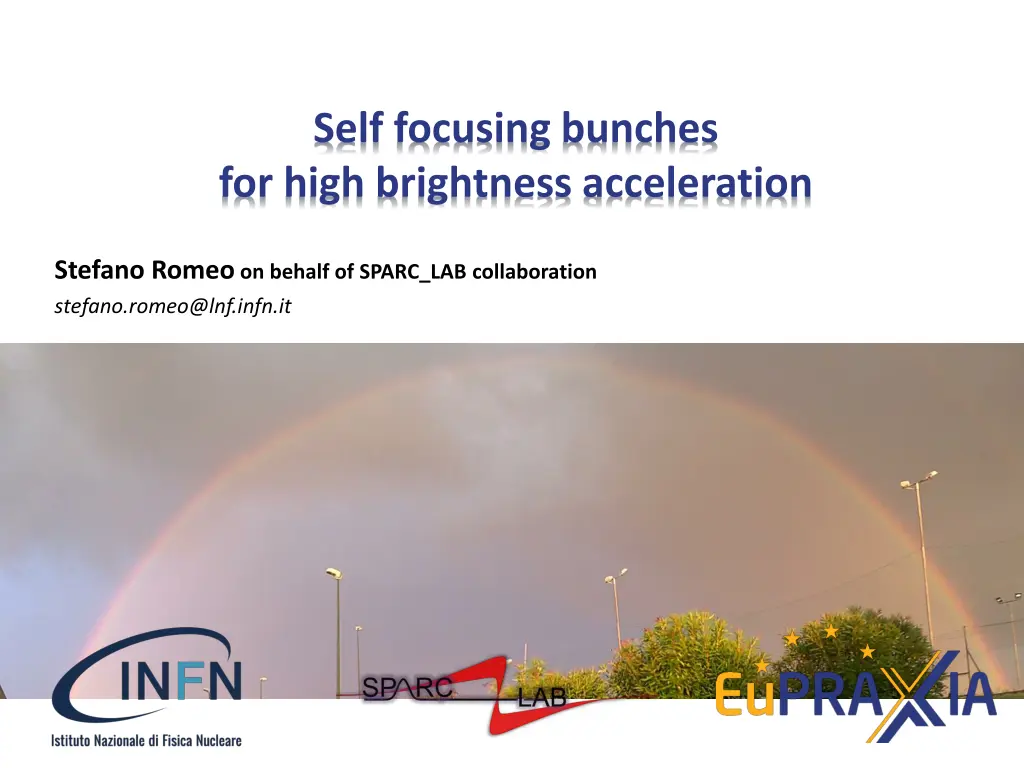
Self-Focusing Bunches for High Brightness Acceleration
Explore the concept of self-focusing bunches for high brightness acceleration in particle accelerators. Learn about beam loading effects, linear regimes, transverse contributions, and energy spread growth for high-quality acceleration. Witness transverse matching, beam loading compensation, and important considerations for achieving optimum beam quality. Discover insights from studies on energy loss analysis, accelerating field equations, and plasma-based accelerators.
Download Presentation

Please find below an Image/Link to download the presentation.
The content on the website is provided AS IS for your information and personal use only. It may not be sold, licensed, or shared on other websites without obtaining consent from the author. If you encounter any issues during the download, it is possible that the publisher has removed the file from their server.
You are allowed to download the files provided on this website for personal or commercial use, subject to the condition that they are used lawfully. All files are the property of their respective owners.
The content on the website is provided AS IS for your information and personal use only. It may not be sold, licensed, or shared on other websites without obtaining consent from the author.
E N D
Presentation Transcript
Self focusing bunches for high brightness acceleration Stefano Romeo on behalf of SPARC_LAB collaboration stefano.romeo@lnf.infn.it
Self focusing bunches The driver generates a linear field Witness can be injected on crest The field generated by the witness is non linear Focusing is guaranteed by a beam loading effect 4 ??=2 ? ??= ? ??? 4 1 2?? ?? ??= ?? ? 2 Stefano Romeo Frascati 13/03/2018
High quality acceleration in linear regime Transverse contribution (sliced) 2? ? ? 2????2 ??? 8??,? Spherical aberration coefficient ??= 2 4??,? 4 4??,? 4 4??,? 4?(0) 2??,? 4 2 +3?? +3?? 16?2(0) ?? 2+ 1 ?0 2??,? tan2?0?? 2 ??,?= ??,? ? Bunch length LT correlation Chirp Energy spread growth High quality requires: ??,? ??,? ????,? 1 In many realistic cases, beam loading is not negligible 3 Stefano Romeo Frascati 13/03/2018
Energy spread growth Barov, Nick, et al. "Energy loss of a high-charge bunched electron beam in plasma: Analysis." Physical Review Special Topics-Accelerators and Beams 7.6 (2004): 061301. The longitudinal field generatedby a low chargehigh density bunch can be described by linear equations The beam loading compensationoccurs whenthe first derivative of the acceleratingfield in the center of the witness is 0 Chiou, T. C., and T. Katsouleas. "High beam quality and efficiency in plasma-based accelerators." Physical review letters 81.16 (1998): 3411. LCLS, CDR, ch07. SLAC From the analytical model of field it is possible to evaluatethe energy spread ??? ??= 0 sin?0=?? Beam loading compensation ?? For any witness in a great range of parameters it s possible to find a bunch separation that guarantees beam loading compensation 23?? 4??,? 4 Energy spread growth depends only on witness length 4 2+ 1 ?0 ??,?= ??,? ? 4 Stefano Romeo Frascati 13/03/2018
Witness transverse matching A correlated focusing on longitudinal dimension causes emittance growth ??,?=?2??2? ?2? ? Energy spread compensation using beam loading (NO BUNCH SHAPING) Hypotesis of quasi-linearity Lu, W., et al. "A nonlinear theory for multidimensional relativistic plasma wave wakefields a." Physics of Plasmas 13.5 (2006): 056709. ??? ??= 0 ?(?? ???) ?? = 0 ??= 0 ?(?? ???) ?? ?? ??,?= 0 ??= 0 = 0 Consequences ? =?0 4 1 2?? ?? Ion column model can be applied Stupakov, G., et al. "Wake excited in plasma by an ultrarelativistic pointlike bunch." Physical Review Accelerators and Beams 19.10 (2016): 101302. ??= ? 2 5 Stefano Romeo Frascati 13/03/2018
SPARC_LAB layout for beam driven PWFA experiments ? ??? ??? ??? ? ?.? ? ?? ???? ??< ?.?% ??= ? ?? ?? High quality PWFA Beam diagnostic Photoinjector that allows to create trains of high quality electron bunches C band accelerating cavity 2 S band acceleratingcavities (velocity bunching) FEL 6 Stefano Romeo Frascati 13/03/2018
Working point design General comprehension of a phenomenon / Proof of principle SPARC_LAB Working Point Driver Injection Witness Injection ? 200 200 ??[ m] 10.3 1.26 Limited number of simulations 37.2 3 ??[ m] ??[%] 0.1 0.1 ??[ m] 17 0.3 Detailed analysis of phenomenon features / Optimization of working point ?[pC] 200 10 ?[kA] ? ?0[cm 3] 0.68 0.42 1.2 0.06 2 1016 Parametric scans 1-2 ??[GV/m] 5 ?[cm] 7 Stefano Romeo Frascati 13/03/2018
Hybrid Tool: Architect Bunch(es) are treated kinetically background plasma as a fluid cylindrical symmetry assumed run time figure of merit: 1cm/h no-Quasi Static Approximation ???????????= ? ? + ?????????? ? dt?????????= ?????????? ????= ? ????? ????= ? ?? ??? + ? ? + ??? ? ??? = ? ? ??? = ?2? ? ??0?3(????+ ????) Code reliability respect to full PIC code showed both for linear and quasi-linear regimes 8 Stefano Romeo Frascati 13/03/2018
Bunch separation scan sin?0=Q? ?? The model developed for the scheme doesn t forsee the driver head erosion effects A simulation scan is required in order to evaluate ?0 Optimal injection distance ?.????? 9 Stefano Romeo Frascati 13/03/2018
Witness longitudinal phase space 10 Stefano Romeo Frascati 13/03/2018
Outcoming witness parameters SPARC_LAB Working Point Driver Injection Witness Injection Witness Extraction ? 200 200 300 ??[ m] 10.3 1.26 1.3 ??[ m] 37.2 3 3 ??[%] 0.1 0.1 0.2 ??[ m] 17 0.3 0.31 ?[pC] 200 10 10 ?[kA] 0.68 0.42 0.42 ? 1.2 0.06 0.06 ?0[cm 3] 2 1016 ??[GV/m] 1 ?[cm] 5 11 Stefano Romeo PhD defense La Sapienza, University of Rome 2017/09/20
Stability analysis A scan of 30 simulation was performed using the latin hypercube sample in order to analyze the working point It was useful to prove the robustness of the scheme ? = 157 7.2 MeV ??= 0.307 0.005 mm mrad ??= 0.4 0.15% 12 Stefano Romeo Frascati 13/03/2018
Conclusions Results Low energy working point Scaling laws Future perspectives Model for head erosion Cross-check of the results with full PIC/3D codes Simulation scan in order to propose a possible EuPRAXIA working point is on chart 13 Stefano Romeo PhD defense La Sapienza, University of Rome 2017/09/20






















